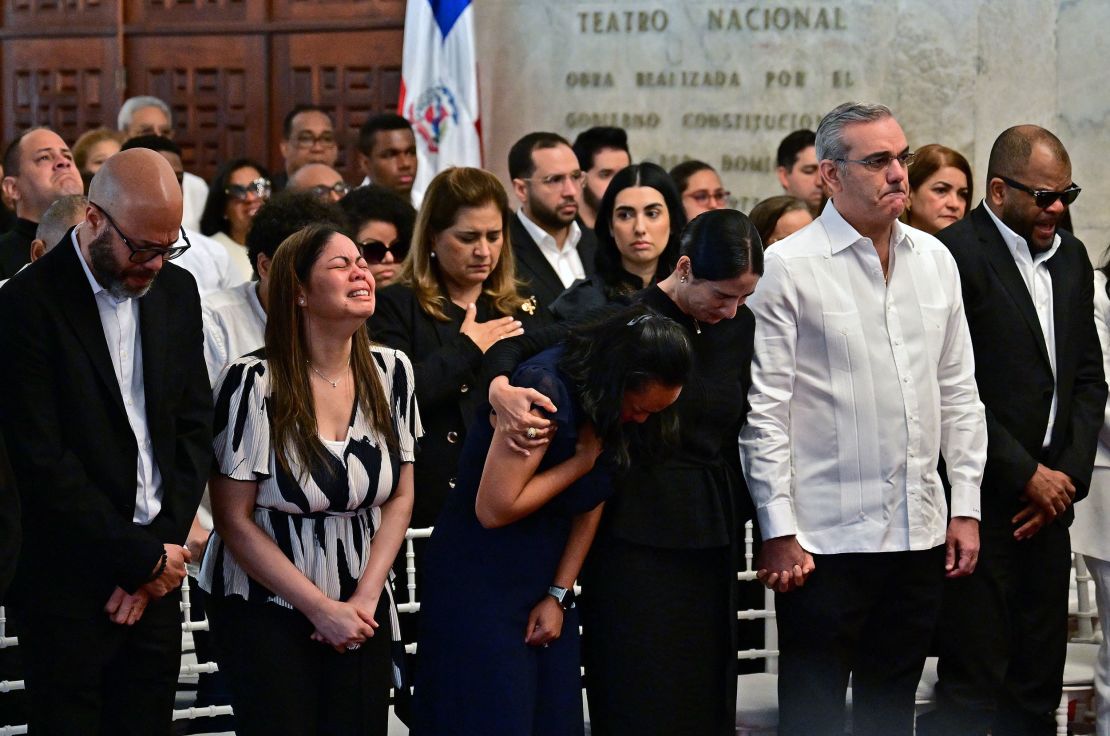CNN
—
More than 200 people died after the roof of the popular Jet Set nightclub collapsed in the Dominican Republic’s capital, Santo Domingo, this week in one of the Caribbean country’s deadliest tragedies.
Footage from the scene early Tuesday morning showed how a celebratory event turned into a disaster. Beloved merengue singer Rubby Pérez is first seen serenading the crowd, accompanied by his orchestra.
Moments later, the club’s disco balls begin to sway before the roof suddenly collapses. Screams and crashing sounds can be heard for several seconds before the video cuts out.
The deadly incident claimed the lives of several prominent Dominicans, including at least two former Major League Baseball players and Pérez, sending shockwaves throughout the country as investigators frantically seek its cause.
Here’s what we know:
The search for survivors ends
The collapse killed at least 221 people and dozens more were rescued from the rubble, Dominican officials said as it was announced Thursday that crews had completed the days-long search for survivors.
“All reasonable possibilities of finding more survivors” had been exhausted,” Dominican emergency authorities said, adding that the focus of their operation is now recovering bodies.
Many who died suffered from traumatic head injuries, Dominican Republic Health Minister Victor Atallah said. “Most of the deceased died instantly,” Atallah said, according to local newspaper El Caribe. “Many were sitting; the ceiling fell on their heads and chests.”
Search efforts have also taken a mental toll on rescue workers. “You hear people who are trapped, screaming for help – it’s a bit difficult,” Daniel Heredia, a member of the Dominican Civil Protection Service, told CNN.
At a Thursday press conference, the director of the country’s emergency services wept as he described the scale of the tragedy.
“Today, I conclude the hardest job I’ve ever done in my 20 years of service,” Juan Manuel Méndez, director of the Dominican Emergency Operations Center.
Investigation continues
The Jet Set is one of the country’s most high-profile venues, close to the busy El Malecón thoroughfare in the heart of Santo Domingo. Its Monday night events are among its best attended.
Hundreds of people were believed to be in the club when the roof collapsed early Tuesday morning.
Among the survivors is Javier Molleja, who told CNN that he heard a “horrible and immense sound” when the club’s roof caved in. He was with his mother and managed to escape with her.
“It was immediate,” Molleja said of the roof collapse. “Everything fell. I mean, absolutely everything.”
In pictures: Nightclub roof collapse in Dominican Republic
The exact cause of the disaster is currently under investigation. On Thursday, the Dominican presidency announced the creation of an investigative commission into the disaster’s exact cause, comprised of “leading experts” from both the Dominican Republic and abroad.
The nightclub was built more than 50 years ago, according to local media reports, and had a capacity to hold up to 500 people.
Aerial footage now shows the venue with a wide, gaping hole in the middle of the building where the audience would have been located during the performance.
Jet Set owner Antonio Espaillat said the club is maintaining “full and transparent” cooperation with authorities responding to the collapse.
“From the very beginning, we have been collaborating fully and transparently with the authorities,” Espaillat said in a statement video posted hours after the accident on the club’s Instagram account.
“We remain in constant communication with (emergency services), as search and rescue efforts continue with emergency teams, volunteers, and personnel from more than 22 institutions.”
Speaking to reporters Thursday, prosecutor Rosalba Ramos said that once the debris is removed at Jet Set “we will begin expert reports in the disaster’s ground zero and contact family members to come to the prosecutor’s office for recovered belongings and other procedures.”
A country mourns
The club often attracts celebrity patrons, and among the dead are numerous notable figures in Dominican culture, sports and politics.
Pérez, the 69-year-old singer who died during his performance, was known as the “Loudest Voice in Merengue.” His daughter Zulinka was also singing with him when the nightclub’s ceiling collapsed.
She told CNN affiliate Univision that her father saved her life. After the collapse, Zulinka said she told Pérez from under the rubble that she couldn’t exert herself because she was recovering from surgery.
Pérez told his daughter, “Okay, stay where your microphone is and I’ll stay where mine is,” Zulinka said.
If he hadn’t consoled her, “I wouldn’t be here,” Zulinka told Univision.

Footage of Pérez’s memorial service at the National Theatre in Santo Domingo on Thursday shows Dominican President Luis Abinader among the mourners. The singer’s trademark hat and sunglasses were placed atop his casket, along with a wreath bearing the message “Always With Us.”
At least two former Major League Baseball players also perished in the disaster. Octavio Dotel, who won the World Series while pitching for the St. Louis Cardinals in 2011, died en route to the hospital.
Tony Blanco, a former player for the Washington Nationals, was also killed, according to MLB Commissioner Robert Manfred and the Dominican Republic’s Ministry of Sports.
At least one US citizen and an unknown number of US residents died in the incident, US Secretary of State Marco Rubio said Wednesday in a statement on X.
Nelsy Cruz, the governor of Monte Cristi province, also died at the scene, according to Dominican President Luis Abinader.
Almost immediately after the roof caved in, Cruz called President Abinader to alert him of the tragedy even while she was trapped under the rubble, according to First Lady Raquel Arbaje. “The president started mobilizing all the organizations” to send help right after the call, she said.
On April 10, Abinader extended what was initially a three-day period of mourning for an additional three days.
CNN’s Ana Melgar, Michael Rios, Verónica Calderón, Sophie Tanno and Stefano Pozzebon contributed reporting.

